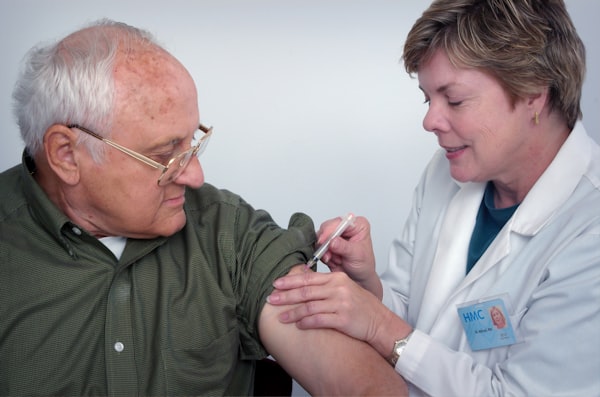Is Glaucoma an Age-related Decline?

Introduction to Glaucoma
Glaucoma is one of the most common, yet least understood, eye diseases that affecting people around the world. It can cause irreversible vision loss if left untreated, and it is estimated that over 3 million people in America alone already have glaucoma. There is currently no known cure for glaucoma, so it is important to take preventive measures and be aware of its symptoms.
Recent research has shown that glaucoma may be an age-related decline, but the exact connection is not fully understood. In this guide, we'll explore what glaucoma is, its potential relationship to age, how to recognize the symptoms, available treatments, and steps you can take to protect your vision.
Defining Glaucoma
Glaucoma is an eye condition which is often age-related and is marked by a gradual loss of vision. It is the result of damage to the optic nerve, which sends signals from the eye to the brain. The cause of this damage is usually increased pressure within the eye caused by accumulation of fluid. This excess fluid increases the pressure inside the eye, which in turn can cause the nerve fibers that transmit signals from the eye to the brain to be damaged. In extreme cases, it may lead to total blindness.
If left untreated, glaucoma can lead to progressive and irreversible vision loss. It is essential for individuals to get regular eye exams in order to detect any ocular issues, such as glaucoma, early on.
Causes of Glaucoma
When the pressure inside our eyes increases, it can lead to a condition called glaucoma. This increased pressure can occur due to many factors, including age-related decline.
The most common cause of pressure in the eye is related to the production and drainage of the fluid (aqueous humor) in the eye. The aqueous humor continually circulates through the eye, and its production is regulated by our bodies. This fluid helps maintain the shape and thickness of our cornea.}
If this fluid does not drain properly, it can build up and cause an increase in the pressure inside of the eye. This increase in pressure can cause damage to the optic nerve, which can lead to vision problems and blindness.
While age-related decline can be a factor in causing glaucoma, it is important to note that there are other causes as well, such as genetic predisposition, diabetes, hypotension, trauma, and certain medications. Additionally, individuals who are nearsighted may be at an increased risk of developing glaucoma.
Symptoms and Diagnosis
Before you can get treatment for glaucoma, your doctor needs to diagnose you. This can be done by testing your vision and the pressure inside your eyes.
Glaucoma is typically symptomless in its early stages, which often makes early detection difficult. Once the condition advances, you may start to experience symptoms such as blurred vision, tunnel vision, eye pain, headaches, and rainbow-like halos around lights. If you start to experience these symptoms, it’s important to see your doctor for a diagnosis.
Your doctor is also likely to use special equipment to look inside your eyes in order to diagnose your condition. By checking the shape of the optic nerve and measuring the pressure inside your eyes, they’ll be able to determine if you have glaucoma and what type it is. They may also perform tests such as a visual acuity test, which is used to measure your vision’s clarity and sharpness.
If you think you may have glaucoma, it’s important to visit your doctor right away for an examination and diagnosis. Early diagnosis can help you avoid serious vision loss down the line.
Glaucoma and Age-Related Decline
As people age, the risk of developing glaucoma increases. This is because the tissues surrounding the eye, which help to regulate fluid pressure, become weaker with age. As a result, more pressure is applied to the nerve endings and can cause damage to the optic nerve, resulting in vision loss or decreased vision. Age-related decline is the most common form of glaucoma and is typically diagnosed in individuals over the age of 40.
Although glaucoma can be associated with normal aging, it is not the same as age-related macular degeneration (AMD). Both diseases can cause a decrease in vision, but AMD affects the central area of the eye, while glaucoma affects the side areas. While AMD results in blurriness, glaucoma can cause blind spots and tunnel vision.
It is important to note that age-related decline is not the only type of glaucoma. Other types of glaucoma, such as acute angle-closure glaucoma, can occur at any age and should be taken seriously. Furthermore, glaucoma may not always have noticeable symptoms until it has progressed significantly, making regular check-ups with an optometrist critical for maintaining overall eye health.
Types of Glaucoma Related to Age
Age-related eye conditions such as glaucoma can affect all ages. However, the type and severity may vary depending on age. There are three primary types of glaucoma which often affect those 60 years and older:
- Primary Open-Angle Glaucoma (POAG)
- Low-Tension Glaucoma
- Normal-Tension Glaucoma
POAG is the most common type of glaucoma found in those over 60 and is when fluid pressure builds up within the eye. This pressure can damage the optic nerve and lead to vision loss. Low-tension glaucoma is when the pressure within the eye is lower than usual and results in gradual sight loss. Normal-tension glaucoma is when the pressure within the eye is at a normal level, but the vision still declines.
Preventing Glaucoma
Glaucoma is a serious eye condition that can lead to vision loss. While there is no known method of cure, it is possible to prevent the progression of the disease. Understanding the various risk factors and taking preventive steps can help reduce the risk of developing glaucoma.
Regular eye health check-ups can help identify any early signs of glaucoma so that further treatment can be pursued. Those who are at an increased risk of glaucoma should get their eyes checked more often than those who are not. People aged over 40, particularly those of African or Hispanic descent, should have their eyes checked every two years.
Adopting good eye care practices can also help reduce the risk of glaucoma. This includes eating a balanced diet and avoiding activities that put strain on the eyes, such as computer use and watching television for extended periods of time. Additionally, protective eyewear, such as sunglasses, should be worn when outdoors to reduce exposure to ultraviolet (UV) light.
Finally, medications may be prescribed by a doctor to help reduce eye pressure and slow down the progression of glaucoma. These may include eye drops that help lower eye pressure, as well as systemic medications, such as beta-blockers or diuretics.
Available Treatments for Glaucoma
Glaucoma is a serious eye condition that, if left untreated, can lead to blindness. Fortunately, there are various treatments available for managing the condition. These treatment options aim to reduce and maintain stable intraocular pressure in order to protect and preserve vision.
The most common form of treatment for glaucoma is eye drops. These eye drops help reduce intraocular pressure by reducing the production of aqueous humour or encouraging its drainage from the eye. Some types of eye drops contain prostaglandins, which can act as an anti-inflammatory agent and also help increase the outflow of fluid from the eye. Other types of eye drops may contain beta blockers, alpha agonists, or carbonic anhydrase inhibitors.
If eye drops are not effective in managing glaucoma, laser surgery can be performed to reduce intraocular pressure. Laser trabeculoplasty involves using a laser to open up drainage pathways. This helps reduce the amount of fluid being produced and allows it to drain more easily. Another form of laser surgery, called cyclophotocoagulation, is used to reduce the production of aqueous humour.
Surgical treatment can also be used to reduce intraocular pressure. In these cases, a portion of the occluded part of the eye is surgically removed. This can help improve fluid outflow from the eye. In more complex cases, a tube shunt may be placed in the eye to help direct fluid flow away from the eye.
Maintaining Optimal Eye Health
Our eyes are delicate structures that require proper care and regular attention. Maintaining optimal eye health is key to preventing the onset of glaucoma, especially when age is a factor. Regular eye exams should be scheduled every two years for adults between the ages of 20 and 40, and at least once a year for those over the age of 40. During these exams, your eye doctor will be able to detect any signs or symptoms that could potentially lead to glaucoma.
It is also important for people to take preventative measures to ensure their eyes remain healthy. This includes wearing sunglasses to protect your eyes from UV rays, quitting smoking, maintaining a healthy diet rich in fruits and vegetables, and avoiding triggers such as allergies, dust, and pollution.
Regular exercise has also been linked to improved ocular health and proper functioning. Exercise helps to improve blood flow and circulation, both of which are essential for the maintenance of eye health. Additionally, exercise helps reduce stress, an often-overlooked cause of poor eye health. Stress and tension can lead to fatigue, which can impair vision.
Contributing Factors for Increased Risk
Age is one of the leading contributors to an increased risk of glaucoma, and as we get older, our risk for developing this condition increases. Other contributing factors can include family history of glaucoma, certain genetic mutations, a history of long-term steroid use, medical conditions like diabetes, and having very high eye pressure. In addition, eye injuries and trauma can also increase your risk of developing glaucoma.
Eye Health Practices
Individuals can take steps to reduce their risk for glaucoma, especially if they are in the higher risk age group or have other risk factors. Regular eye exams are critical for detecting signs of glaucoma early on, and for ensuring that any symptoms or conditions are managed appropriately.
Wearing eye protection when playing sports or working with tools is important, to prevent any injury to the eyes. Those who wear contact lenses should follow the replacement instructions provided by their doctor. Proper nutrition is also encouraged, as it can help maintain overall eye health and reduce the risk of developing glaucoma.
Living with Glaucoma
The challenges of living with glaucoma can be daunting, but there is hope. With regular monitoring, lifestyle changes, and the correct management of the condition, individuals can lead healthy, productive lives.
It’s important to keep up with regular eye exams and to follow any recommendations from your healthcare provider. Your doctor may recommend lifestyle changes such as limiting time spent in extremely bright environments and avoiding activities that could increase eye pressure. Avoiding smoking, managing stress, and eating a healthy diet are also part of reducing risk for glaucoma.
Should you require treatment, there are several options available. Medical treatments, such as oral medications, eye drops or surgery, can slow down the progression of vision loss. Additionally, adaptive devices, like low vision aids, can help those with difficulty performing daily activities, such as reading or driving. If you have any questions or concerns about treatment options, it’s important to talk to your doctor.
Living with glaucoma can sometimes cause feelings of stress or sadness. It’s important to talk to your loved ones about how you’re feeling. You may find comfort and reassurance from others who have experienced similar situations. Additionally, support groups or counseling can provide you with additional resources and help.
Conclusion
Glaucoma is a serious eye condition that can develop at any age, though it could be more common in older people due to the effects of aging on the eyes. With early detection and appropriate treatment, most types of glaucoma can be managed in order to prevent vision loss and preserve optimal eye health. However, it is important to maintain regular check-ups and be aware of the warning signs in order to diagnose any potential eye-related issues. Prevention is the best approach, and by understanding your risk factors and taking care of your eyes, you can reduce your chances of developing glaucoma.





